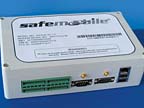Remote Tracking Spreads

While no single solution will guarantee absolute security for the nation’s school buses, using technology reduces risks. Investment and installation of security systems, like video and global positioning systems (GPS), enhances bus security.
Advances, particularly GPS-based automatic vehicle location (AVL) technology, make it possible to address safety concerns in a tangible, financially feasible manner. GPS/AVL allows dispatchers to see the position of an individual school bus or entire fleet at all times. By receiving signals from GPS satellites, a fleet or security manager can continuously compute vehicle locations and manage real-time situations.

The most robust systems have duress alarms that allow drivers to silently alert the dispatcher and/or emergency personnel. When an alarm is triggered, digital video recorders are turned on to provide real-time video streams to dispatchers and emergency personnel. In some cases, the system has a dirty bomb detection option.
Investment decisions
“Adding GPS and student tracking technology to pupil transportation operations dramatically increases student security without compromising privacy,” said Mike Darling, senior vice president of Education Logistics Inc., the Missoula, Mont., solutions firm. “When these systems are integrated with the data contained in routing and scheduling software, school districts can manage by exception: they can know instantly if a child is missing, if a bus is off route, or if an emergency is occurring.”School districts across the country are investing in GPS/AVL technology for its economic and security benefits. The Department of Defense’s Education Activity already uses such technology to protect students and school buses on an undisclosed number of military bases in the United States and abroad. In these instances, not only are the buses themselves tracked, so too are the children onboard the buses. Using radio frequency identification tags pinned to student backpacks, the system identifies each student as they get on and off the school bus.
Looking for a reprint of this article?
From high-res PDFs to custom plaques, order your copy today!






